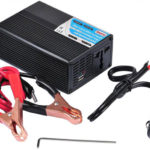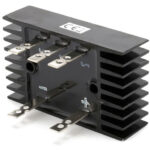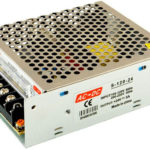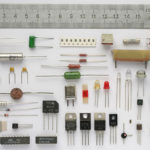The budget option for converting the main parameters of electric current are voltage dividers. Such a device is easy to make on your own, but to do this, you need to know the purpose, applications, principle of operation and calculation examples.

Content
Purpose and application
A transformer is used to convert alternating voltage, thanks to which a sufficiently high current value can be maintained. If it is necessary to connect a load that consumes a small current (up to hundreds of mA) to an electrical circuit, then the use of a voltage transformer (U) is not advisable.
In these cases, you can use the simplest voltage divider (DN), the cost of which is much lower. After obtaining the required value, U is straightened and power is supplied to the consumer. If necessary, to increase the current (I), you need to use the output stage to increase the power.In addition, there are divisors and constant U, but these models are used less often than others.
DNs are often used to charge various devices in which it is necessary to obtain lower values of U and currents from 220 V for different types of batteries. In addition, it is advisable to use devices for dividing U to create electrical measuring instruments, computer equipment, as well as laboratory pulsed and ordinary power supplies.
Principle of operation
A voltage divider (DN) is a device in which the output and input U are interconnected using a transfer coefficient. The transfer coefficient is the ratio of the values of U at the output and at the input of the divider. The voltage divider circuit is simple and is a chain of two consumers connected in series - radio elements (resistors, capacitors or inductors). They differ in terms of performance.
Alternating current has such main quantities: voltage, current, resistance, inductance (L) and capacitance (C). Formulas for calculating the basic quantities of electricity (U, I, R, C, L) when consumers are connected in series:
- The resistance values add up;
- The stresses add up;
- The current will be calculated according to Ohm's law for the circuit section: I = U / R;
- Inductances add up;
- Capacitance of the entire capacitor chain: C = (C1 * C2 * .. * Cn) / (C1 + C2 + .. + Cn).
For the manufacture of a simple resistor DN, the principle of series-connected resistors is used. Conventionally, the scheme can be divided into 2 shoulders. The first shoulder is the upper one and is located between the input and the zero point of the DN, and the second is the lower one, and the output U is removed from it.
The sum of U on these arms is equal to the resulting value of the incoming U. There are linear and non-linear types of RPs. Linear devices include devices with output U, which varies linearly depending on the input value. They are used to set the desired U in various parts of the circuits. Nonlinear are used in functional potentiometers. Their resistance can be active, reactive and capacitive.
In addition, DN can also be capacitive. It uses a chain of 2 capacitors that are connected in series.
Its principle of operation is based on the reactive component of the resistance of capacitors in a current circuit with a variable component. The capacitor has not only capacitive characteristics, but also resistance Xc. This resistance is called capacitive, depends on the frequency of the current and is determined by the formula: Xc \u003d (1 / C) * w \u003d w / C, where w is the cyclic frequency, C is the value of the capacitor.
The cyclic frequency is calculated by the formula: w = 2 * PI * f, where PI = 3.1416 and f is the AC frequency.
Capacitor, or capacitive, type allows you to receive relatively large currents than with resistive devices. It has been widely used in high-voltage circuits, in which the value of U must be reduced several times. In addition, it has a significant advantage - it does not overheat.
The inductive type of DN is based on the principle of electromagnetic induction in current circuits with a variable component. The current flows through the solenoid, the resistance of which depends on L and is called inductive. Its value is directly proportional to the frequency of the alternating current: Xl \u003d w * L, where L is the value of the inductance of the circuit or coil.
Inductive DN works only in circuits with current, which has a variable component, and has an inductive resistance (Xl).
Advantages and disadvantages
The main disadvantages of a resistive DN are the impossibility of its use in high-frequency circuits, a significant voltage drop across resistors and a decrease in power. In some circuits, it is necessary to select the power of the resistances, since significant heating occurs.
In most cases, alternating current circuits use DN with an active load (resistive), but with the use of compensation capacitors connected in parallel to each of the resistors. This approach allows you to reduce heat, but does not remove the main drawback, which is power loss. The advantage is the use in DC circuits.
To eliminate power loss on a resistive DN, active elements (resistors) should be replaced with capacitive ones. The capacitive element relative to the resistive DN has a number of advantages:
- It is used in AC circuits;
- No overheating;
- Power loss is reduced, since the capacitor does not have, unlike the resistor, power;
- Application in high-voltage voltage sources is possible;
- High efficiency factor (COP);
- Less loss on I.
The disadvantage is that it cannot be used in circuits with constant U. This is due to the fact that the capacitor in DC circuits does not have capacitance, but only acts as a capacitance.
Inductive DN in circuits with a variable component also has a number of advantages, but it can also be used in circuits with a constant value of U.The inductor has resistance, but due to the inductance, this option is not suitable, as there is a significant drop in U. The main advantages compared to the resistive type of DN:
- Application in networks with variable U;
- Slight heating of the elements;
- Less power loss in AC circuits;
- Relatively high efficiency (higher than capacitive);
- Use in high-precision measuring equipment;
- Has a smaller error;
- The load connected to the output of the divider does not affect the division ratio;
- Current loss is less than that of capacitive dividers.
The disadvantages include the following:
- The use of constant U in power networks leads to significant current losses. In addition, the voltage drops sharply due to the consumption of electrical energy for the inductance.
- The output signal in frequency response (without the use of a rectifier bridge and filter) changes.
- Not applicable to high voltage AC circuits.
Calculation of the voltage divider on resistors, capacitors and inductances
After choosing the type of voltage divider for the calculation, you need to use the formulas. If the calculation is incorrect, the device itself, the output stage for amplifying the current, and the consumer may burn out. The consequences of incorrect calculations can be even worse than the failure of radio components: fire as a result of a short circuit, as well as electric shock.
When calculating and assembling the circuit, you must strictly follow the safety rules, check the device before turning it on for correct assembly and do not test it in a damp room (the likelihood of electric shock increases). The main law used in the calculations is Ohm's law for the circuit section.Its formulation is as follows: the current strength is directly proportional to the voltage in the circuit section and inversely proportional to the resistance of this section. The formula entry looks like this: I = U / R.
Algorithm for calculating the voltage divider on resistors:
- Total voltage: Upit \u003d U1 + U2, where U1 and U2 are the U values on each of the resistors.
- Resistor voltages: U1 = I * R1 and U2 = I * R2.
- Upit \u003d I * (R1 + R2).
- No load current: I = U / (R1 + R2).
- U drop across each of the resistors: U1 = (R1 / (R1 + R2)) * Upit and U2 = (R2 / (R1 + R2)) * Upit.
The values of R1 and R2 should be 2 times less than the load resistance.
To calculate the voltage divider on capacitors, you can use the formulas: U1 = (C1 / (C1 + C2)) * Upit and U2 = (C2 / (C1 + C2)) * Upit.
The formulas for calculating DN on inductances are similar: U1 = (L1 / (L1 + L2)) * Upit and U2 = (L2 / (L1 + L2)) * Upit.
Dividers are used in most cases with a diode bridge and a zener diode. A zener diode is a semiconductor device that acts as a stabilizer U. Diodes should be selected with a reverse U higher than that allowed in this circuit. The zener diode is selected according to the reference book for the required stabilization voltage value. In addition, a resistor must be included in the circuit in front of it, since without it the semiconductor device will burn out.
Similar articles:






